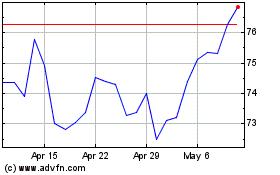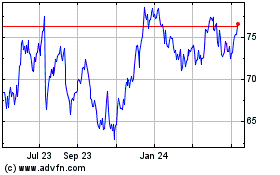Surprising Cry From an Index Firm: 'Go Active'
April 08 2018 - 10:36PM
Dow Jones News
By Bailey McCann
As the bull market gets older, some investment firms --
including indexing powerhouse State Street Corp. -- are expressing
renewed appreciation for actively managed funds.
Why? After years of gains in both stocks and bonds, investment
managers are preparing for bumpier markets, where portfolio returns
could become harder to achieve with long-only directional bets.
"Our headline for 2018 is 'go active,' which may surprise some
people because State Street is most well-known as an index shop,"
says Lori Heinel, deputy global chief investment officer at State
Street Global Advisors. For Ms. Heinel, the persistence of the
stock rally indicates that it may be time to take profits and
consider moving some money into funds whose managers can deploy
strategies designed to manage volatility and offer downside
protection.
Ms. Heinel says changes to U.S. tax law add to her "go active"
thesis, in part because there could be some unintended consequences
for stocks. "There will be more opportunity for managers to look at
the implications of the tax law and how companies are likely to
react. That sets up a stronger stock-picking environment," she
says.
What is the right amount of exposure to active funds? That
depends on an investor's portfolio size, risk tolerance and goals,
many managers say.
Know what you own
Critics have long pointed out that actively managed funds often
come with high fees and long periods of underperformance. In recent
years, investors have turned toward index funds and ETFs,
especially in the U.S., where 36% of fund assets are now passively
managed, up from 17% a decade ago, according to Morningstar
Inc.
But being all in on either passive or active is too binary, says
Andy Schuler, senior vice president and investment director at PNC
Wealth Management, especially when the market may be about to
shift.
"People often relegate active management to the discussion of
managers, but it's also how you make decisions at the portfolio
level about allocations and exposures in response to changes in the
market, so that you stay on track to meet your goals," he says.
Dave Goodsell, executive director of Natixis Investment
Managers' Center for Investor Insight, says there is a perception
that passive funds are innately less risky, but that isn't always
the case.
He notes that individual investors often "struggle with periods
of volatility. They may be surprised to see how their passive
portfolios react without an understanding of their exposures," he
says.
Watch for new risk
Jae Yoon, CIO at New York Life Investment Management, agrees
that it may be time to take profits, even if it looks like the
stock rally will continue. "If anything, passive strategies
themselves are the crowded trade," he says. "If everyone is in
passive, then regardless of the valuations of companies, you're in
a momentum trade," he says. "That trade will eventually be
unwound."
What's more, Mr. Yoon says late-cycle correlations between
stocks and bonds can cause traditional portfolio diversification to
fail. Active funds typically have more flexibility to respond to
that.
New geopolitical risks, including recent U.S. tariff policy,
also could add speed bumps to markets. That, too, could create
opportunities for active management, says Ric Mayfield, a managing
director at SunTrust Advisory Services
Ms. McCann is a writer in New York. She can be reached at
reports@wsj.com.
(END) Dow Jones Newswires
April 08, 2018 22:21 ET (02:21 GMT)
Copyright (c) 2018 Dow Jones & Company, Inc.
State Street (NYSE:STT)
Historical Stock Chart
From May 2024 to Jun 2024

State Street (NYSE:STT)
Historical Stock Chart
From Jun 2023 to Jun 2024
